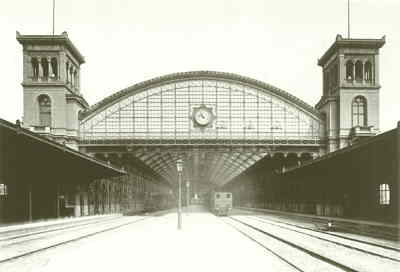Reading Eva-Maria Schnurr's piece (22/11/2012), where she describes the evolution of Berlin from "little more than a swampy backwater", prior to 1870, "to one of Europe's most modern metropolises by 1914", I can't help but feeling awe before the power of capitalism. I can't, either, help feeling that was Schnurr's purpose.
Schnurr provides a vivid account of the transformation of what some call the "built environment", the material structures forming the city: buildings, streets, utilities, transport and communications. Perhaps that's understandable: those are concrete things, mentioned in documents and shown in pictures, even if historical documents and images tend to show only the choicest examples.
 |
| The Brandenburg Gate decorated after the victory in the Franco-Prussian War (1871). [A] |
These changes, Schnurr correctly takes as consequence of economic and political processes: the railroad-facilitated manufacturing and trade ("transforming Berlin in the 1840s into one of central Europe's most important rail hubs"), the change in Berlin's status, from capital of the Kingdom of Prussia, to capital of the German Empire ("the economic boom after 1871, sparked by the receipt of five billion francs in reparations from wartime enemy France"), the growth of the public bureaucracy.
 |
| Berlin Potsdamer Station, by Friedrich Albert Schwartz (1876). [B] |
The piece also succeeds in depicting the demographic transformation brought about by the change in the city's economic base: "By 1864, over half the city's inhabitants were not native Berliners". "Berlin's population in 1849 was only around 412,000, but by 1880 it had passed the 1 million mark. By 1914, 1.84 million people lived in the city, which had become Europe's most densely populated."
Another of Schnurr's achievements is to depict the emergence of a rather sheltered middle-class and the loss of political power by the landed aristocracy.
----------
The things Schnurr focuses on allow one to tell a story about capitalist development. In the surface, is a story of unmitigated progress. It's not a false story, but it's not the whole story and it's not history.
And Schnurr's story makes it difficult to understand the next article in the Der Spiegel series (which I'll comment in the next post).
However, not even Schnurr's narrative can completely hide the other side of the coin. Referring to the "downsides of progress", Schnurr says: "In 1905, while middle-class Tiergarten had an infant mortality rate of 5.2 percent, 42 percent of newborns died in proletarian Wedding".
While the middle-class figure sounds dubious (Tiergarten is traditionally an upmarket area), she does mention the price paid by some sections of the working class for all that development.
----------
The story Schnurr sets out to tell can be illustrated with pictures. If you search the net, you'll find plenty of positive images depicting this period, like those two opening this post.
It takes much more effort to find the other side of the coin:
_459.jpg/624px-Die_Gartenlaube_(1872)_459.jpg) |
| The Freistadt Barackia slum, Tempelhofer Vorstadt, cleared by the police in September 1872. Drawing by L. Loeffler. [C] |
It's as if societies (and individuals, like Schnurr) consciously or not attempted to re-write their own past and re-create it on a sanitized, selective base, leaving aside those less-than flattering bits.
Image Credits:
[A] The Brandenburger Tor with decorations and downcasting Prussian troups after the Franco-Prussian War 1871. Wikipedia.
[B] Berlin Potsdamer Bahnhof, rear view (1876), by Friedrich Albert Schwartz. Wikipedia.
[C] Drawing by L. Loeffler: The slum called «Freistadt Barackia» (i.e. about: Shack-Land Free Town) on Planufer in the Tempelhofer Vorstadt, cleared by the royal police in September 1872. Wikipedia.
No comments:
Post a Comment